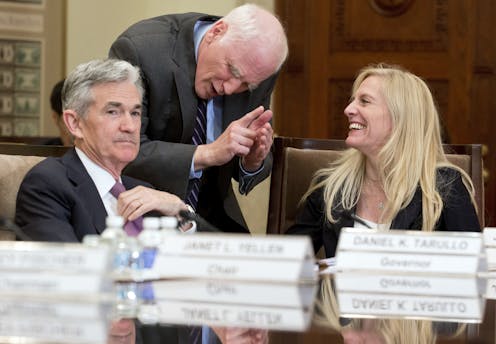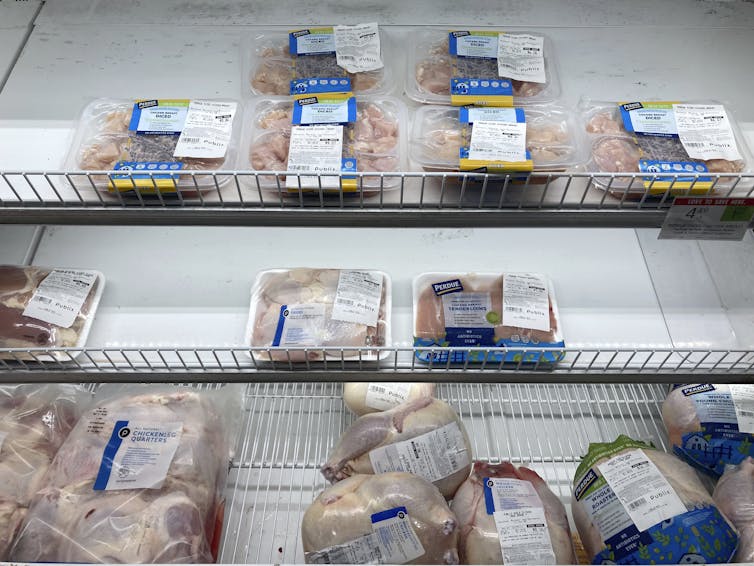Meet the person responsible for keeping inflation from spiraling out of control – without tanking the economy

The person who helms the Federal Reserve is one of the most powerful figures in the world. Their job is also one of the most impactful on the lives of ordinary Americans, not to mention others across the world.
That will be especially true in the coming months as the Fed seeks to tame soaring prices without jeopardizing the economic recovery. The consequences of getting it wrong could be catastrophic and result in higher inflation, a return to recession or, worse, the Fed might have to deal with stagflation – in which you get both rising prices and a sluggish economy.
Jerome Powell is the current chair of the Fed, but his first term expires in February, and progressive Democrats are pushing President Joe Biden to replace him with Lael Brainard, a Harvard economist who is currently serving as the only registered Democrat on the board of governors of the Federal Reserve System. Progressives prefer her in part because she appears to be more sympathetic to more financial regulation and Fed action on climate change.
Wall Street investors, economists like me and other central bankers around the world have been impatiently waiting for Biden’s now-imminent decision for weeks. Markets are predicting Powell is most likely going to keep his job. But would it matter if he picked someone else?
I believe the best way to answer that question is to consider the responsibilities of the Fed and its chair, as well as the serious challenges they will face come 2022 and beyond.
Meet the chair
Most introductory macroeconomics textbooks – like the ones I use to teach my students – note that the chair of the Fed is so influential that he or she can make financial markets crash or soar just by uttering a few words in public. Investors admit they scrutinize and dissect every single word the Fed chair says and even count the number of times a certain key phrase is used – I call it “Fed speech bingo.”
While all of this might be a bit of a hyperbole to make students pay more attention to an admittedly boring chapter on money and banking, it’s undeniable that the Fed chair is very important.
The position is ultimately responsible for regulating the banking system, promoting stability of the financial system and conducting monetary policy by controlling the money supply and setting interest rates – the main duties of the Federal Reserve. Seven governors, including the chair, oversee the Fed, and each has a single vote over key policy decisions like interest rates. But the chair wields significant power by setting the agenda and acting as the public voice of the Fed.
The Fed’s most important job is conducting monetary policy, which involves the control of the money supply in order to promote sustainable economic growth. The main tool used to achieve this is “targeting” the short-term interest rate to achieve low inflation and stable employment. This is what is referred to as the Fed’s dual mandate. In recent years, the Fed has also turned to more unconventional methods, like purchasing commercial bonds and other assets.
What this means for the rest of us is that the Fed helps set the rates we pay on mortgages, car loans, credit cards and other types of borrowing. Lower rates mean credit is cheaper, which boosts the economy. But this in turn can drive up inflation.
The Fed can lift rates to reduce inflation, but raising the cost of credit can hurt economic growth and lead to higher unemployment.
This is exactly the careful balancing act facing the Fed right now.

The dual mandate – hawks and doves
Americans across the country are seeing higher prices at the mall, grocery store and gas pump as inflation, as measured by the Consumer Price Index, shows it soaring at the fastest pace in over three decades. At the same time, the labor market hasn’t fully recovered from the pandemic-induced recession early last year, with 4 million fewer employed people than in February 2020.
The focus for the Fed right now is clearly on the price increases that were initially expected to be short term and should have stabilized by now. Most economists believe the recent price gains reflect temporary supply bottlenecks and the fact that prices fell sharply in spring 2020 at the onset of the pandemic, which make inflation figures now look much larger.
The big decision that the Fed and its chair will have to make in the coming months is when to begin raising interest rates to tame inflation. If they move too much or too soon, they risk causing an economic downturn, which could lead to substantial job losses. If they act too little or too late, they risk letting inflation get out of control – as Americans last experienced in the late 1970s.
In the language used by Fed watchers, this is the difference between being a hawk and a dove. That is, a hawk is more concerned more about fighting inflation, while a dove focuses more on growth and jobs.
While most experts on monetary policy believe things will be pretty similar whether Powell or Brainard is in charge, the latter is slightly more of a dove – meaning she’s seen as more likely to put employment before fighting inflation.
In 2022, the Fed chair will have to quickly decide what its top priority will be – with stagflation being another possible scenario.
Other issues on the chair’s agenda
The Fed is also responsible for fostering stability, integrity and efficiency of the nation’s monetary and financial system, mainly through regulation.
Financial bubbles are inflating in multiple markets from stocks to digital currencies – thanks in part to the Fed’s policy of easy money that has helped drive up prices. Inattention to financial stability was one reason the Fed missed the great financial crisis until it was too late.
The Fed chair will have to decide whether to make this a higher priority, particularly if it lifts interest rates soon. Doing so could cause a market crash.
[Too busy to read another daily email? Get one of The Conversation’s curated weekly newsletters.]
Finally, the Fed is facing pressure to tackle problems beyond its mandate, such as climate change and inequality. This is one of the main reasons Brainard’s in the running in the first place.
Progressive Democrats and activists are urging the Fed to use its regulatory powers to restrict the flow of capital away from carbon-intensive industries and redirect the money toward more climate-friendly ones. This idea is controversial because it’s not in its mandate, it risks hurting Fed independence and can ultimately lead to misallocation of resources.
Similarly, Nobel Prize-winning economist Joseph Stiglitz and other liberals want the Fed to do more to fight inequality. Research shows that the Fed’s policies are contributing to wealth inequality.
While the Fed is probably not able to fix the issues of wealth and income inequality – these are complicated, complex issues requiring congressional action, new legislation or law enforcement – it could at least start to pay more attention to its actions so that it is not actively contributing to the problem.
Continuity or change
But the selection of the Fed chair isn’t the only way Biden will be able to leave his mark on the central bank.
Over the next weeks, he has to fill three other open spots on the Federal Reserve’s board of governors, which provides him with an opportunity for a complete makeover and allows him to shift the Fed’s board toward a more Democratic-dominated one.
This could mean the Fed does end up helping pursue progressive goals like fighting climate change and inequality, perhaps regardless of who the chair is.
Either way, Americans would be wise to pay close attention to whom Biden chooses.
Veronika Dolar does not work for, consult, own shares in or receive funding from any company or organization that would benefit from this article, and has disclosed no relevant affiliations beyond their academic appointment.
from The Conversation – Articles (US) https://ift.tt/3nzpnL4




No comments: